The Book of Judith
VerifiedAdded on 2023/03/31
|8
|1457
|200
AI Summary
The Book of Judith tells the story behind the inglorious defeat of the Assyrians by Judith, a Hebrew woman. This article provides a summary, analysis, and explores the themes of the book.
Contribute Materials
Your contribution can guide someone’s learning journey. Share your
documents today.
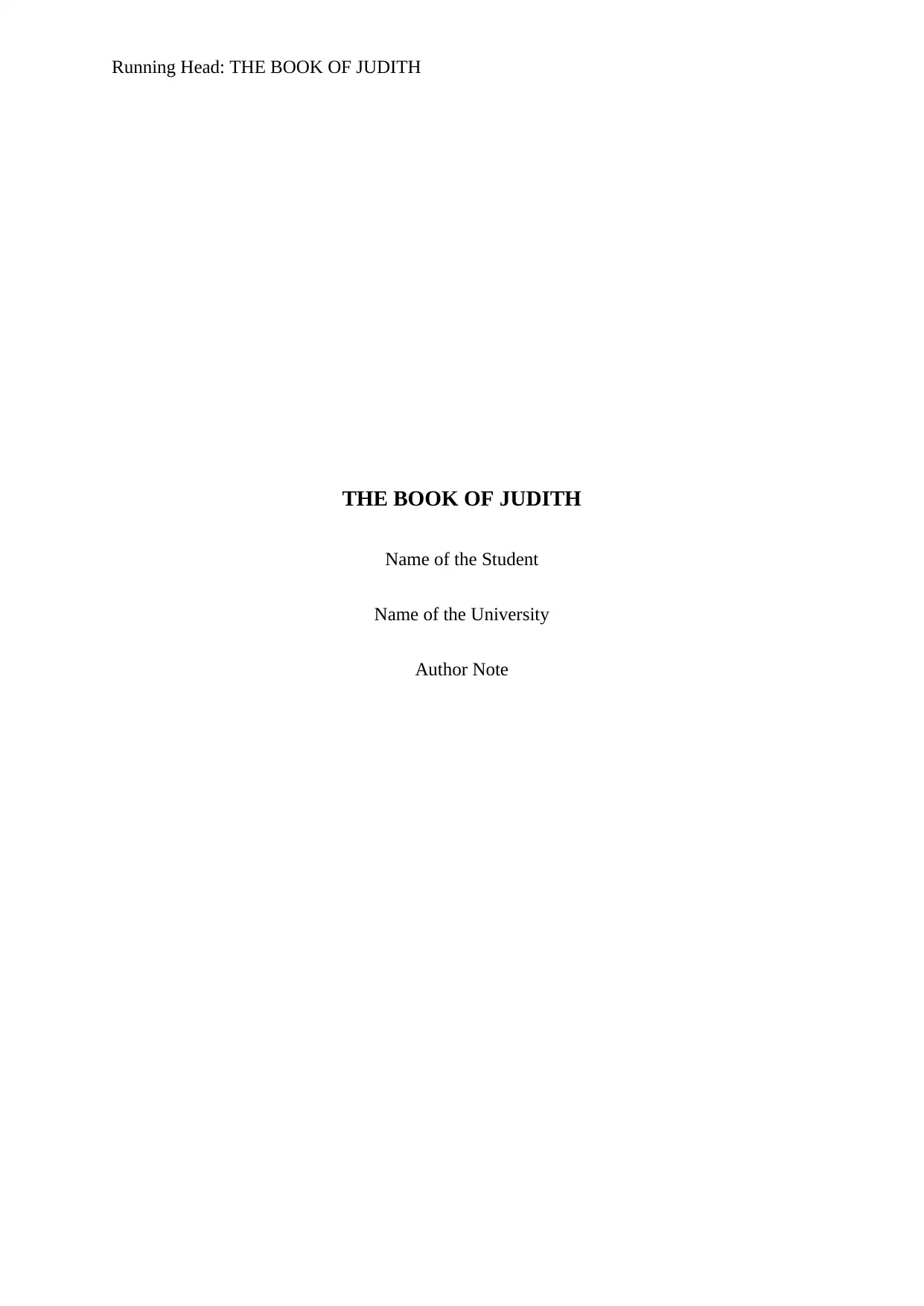
Running Head: THE BOOK OF JUDITH
THE BOOK OF JUDITH
Name of the Student
Name of the University
Author Note
THE BOOK OF JUDITH
Name of the Student
Name of the University
Author Note
Secure Best Marks with AI Grader
Need help grading? Try our AI Grader for instant feedback on your assignments.

1THE BOOK OF JUDITH
The Book of Judith tells the story behind the inglorious defeat of the Assyrians who
were hell bent to dominate the entire world, by Judith, a Hebrew woman. She was marked a
savior, when she beheaded Holofernes, the general of the Assyrian invaders even when he
was surrounded by his army. This was God’s deliverance to the Jewish People. Throughout
the book she is ‘the Hand of a Female’ which recalls the ‘Hand of God’ of the Exodus
narrative. This book is present in the Septuagint and Christian Old Testament of the Bible.
The book is divided into five parts, beginning with the Assyrian threat to Israel (1:1-
3:10), followed by the Siege of Bethulia (4:1 – 7-32) by the Assyrians, which broke the
Jewish Soul, this was followed by the part where Judith, Instrument of the Lord is focused on
(Catholic Online 2019). Judith is a beautiful yet brave widow, who is upset with her
countrymen, who are Jewish, for not believing that God will deliver them from the Assyrians.
The next part focuses on Judith going out to War (10:11 – 13:20), as she leaves Bethulia with
her Loyal maid, to visit the camp of the enemy general, Holofernes. She gains his trust after
promising information about the Israelites to him, and then one night, slips into his tent while
he was resting in a drunken state, decapitates him, and brings his head to the Jews who
counter attack the enemy leading the leaderless army to disperse, in the last part, Victory and
Thanksgiving (14:1 – 16:25).
Judith, in the book is the obvious Protagonist. She is often paired with David because
of her Gender, which is used an example of the Biblical Paradox, ‘Strength in Weakness.’
She plans and leads when the Jews were overcome with fear because of the siege. She is
fearless and willing to act as an instrument of God, to restore belief in the hearts of her
countrymen (Biblical Archaeology Society 2019). Throughout the book, we find that she is
well aware of her charms. She strategizes “to entice the eyes of all the men who see her.”
(Judith 10:4). Her weapon is her power over men as she dresses impeccably and perfumes
herself to capture their senses. In the lethally intimate banquet of seduction back at
The Book of Judith tells the story behind the inglorious defeat of the Assyrians who
were hell bent to dominate the entire world, by Judith, a Hebrew woman. She was marked a
savior, when she beheaded Holofernes, the general of the Assyrian invaders even when he
was surrounded by his army. This was God’s deliverance to the Jewish People. Throughout
the book she is ‘the Hand of a Female’ which recalls the ‘Hand of God’ of the Exodus
narrative. This book is present in the Septuagint and Christian Old Testament of the Bible.
The book is divided into five parts, beginning with the Assyrian threat to Israel (1:1-
3:10), followed by the Siege of Bethulia (4:1 – 7-32) by the Assyrians, which broke the
Jewish Soul, this was followed by the part where Judith, Instrument of the Lord is focused on
(Catholic Online 2019). Judith is a beautiful yet brave widow, who is upset with her
countrymen, who are Jewish, for not believing that God will deliver them from the Assyrians.
The next part focuses on Judith going out to War (10:11 – 13:20), as she leaves Bethulia with
her Loyal maid, to visit the camp of the enemy general, Holofernes. She gains his trust after
promising information about the Israelites to him, and then one night, slips into his tent while
he was resting in a drunken state, decapitates him, and brings his head to the Jews who
counter attack the enemy leading the leaderless army to disperse, in the last part, Victory and
Thanksgiving (14:1 – 16:25).
Judith, in the book is the obvious Protagonist. She is often paired with David because
of her Gender, which is used an example of the Biblical Paradox, ‘Strength in Weakness.’
She plans and leads when the Jews were overcome with fear because of the siege. She is
fearless and willing to act as an instrument of God, to restore belief in the hearts of her
countrymen (Biblical Archaeology Society 2019). Throughout the book, we find that she is
well aware of her charms. She strategizes “to entice the eyes of all the men who see her.”
(Judith 10:4). Her weapon is her power over men as she dresses impeccably and perfumes
herself to capture their senses. In the lethally intimate banquet of seduction back at
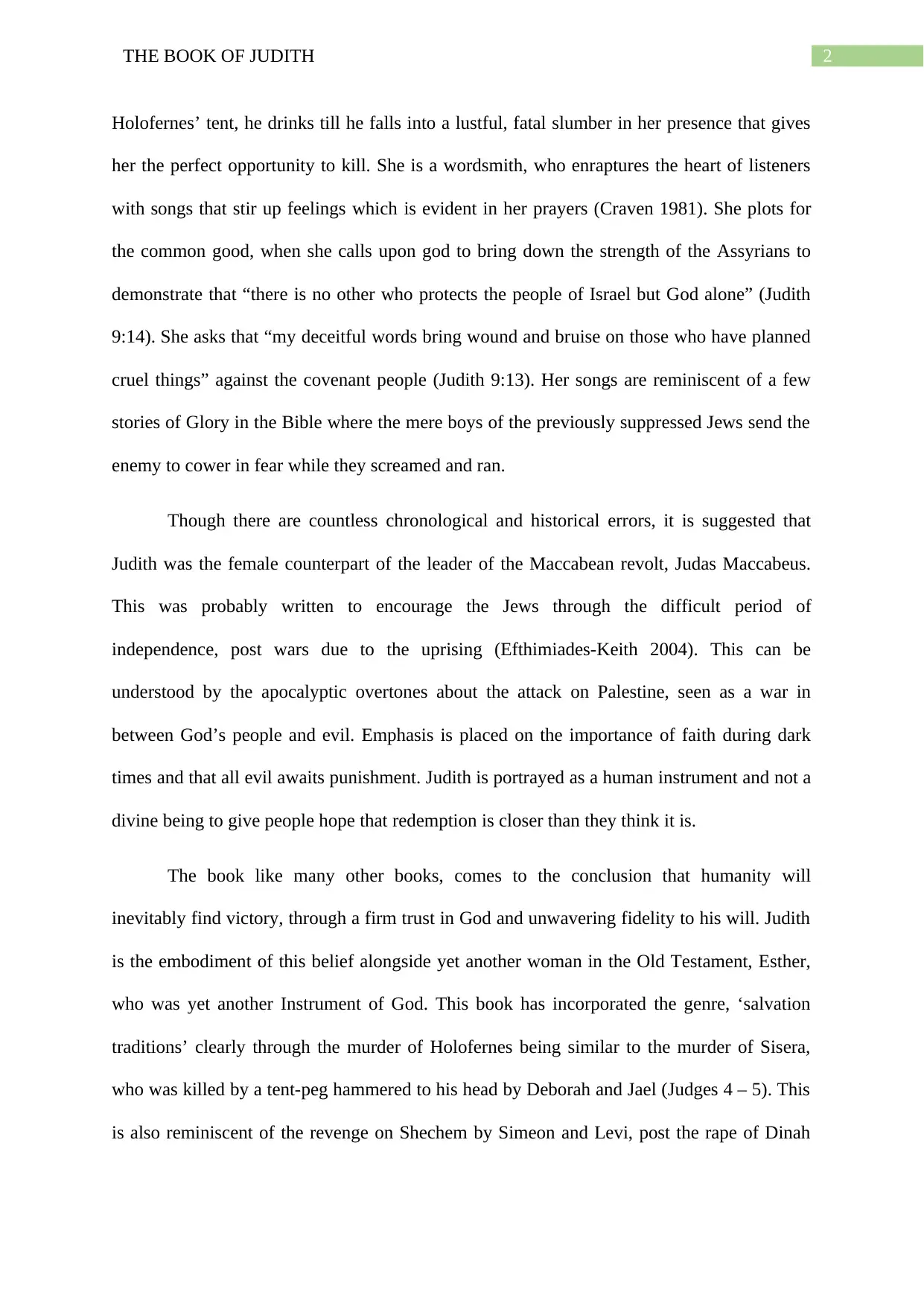
2THE BOOK OF JUDITH
Holofernes’ tent, he drinks till he falls into a lustful, fatal slumber in her presence that gives
her the perfect opportunity to kill. She is a wordsmith, who enraptures the heart of listeners
with songs that stir up feelings which is evident in her prayers (Craven 1981). She plots for
the common good, when she calls upon god to bring down the strength of the Assyrians to
demonstrate that “there is no other who protects the people of Israel but God alone” (Judith
9:14). She asks that “my deceitful words bring wound and bruise on those who have planned
cruel things” against the covenant people (Judith 9:13). Her songs are reminiscent of a few
stories of Glory in the Bible where the mere boys of the previously suppressed Jews send the
enemy to cower in fear while they screamed and ran.
Though there are countless chronological and historical errors, it is suggested that
Judith was the female counterpart of the leader of the Maccabean revolt, Judas Maccabeus.
This was probably written to encourage the Jews through the difficult period of
independence, post wars due to the uprising (Efthimiades-Keith 2004). This can be
understood by the apocalyptic overtones about the attack on Palestine, seen as a war in
between God’s people and evil. Emphasis is placed on the importance of faith during dark
times and that all evil awaits punishment. Judith is portrayed as a human instrument and not a
divine being to give people hope that redemption is closer than they think it is.
The book like many other books, comes to the conclusion that humanity will
inevitably find victory, through a firm trust in God and unwavering fidelity to his will. Judith
is the embodiment of this belief alongside yet another woman in the Old Testament, Esther,
who was yet another Instrument of God. This book has incorporated the genre, ‘salvation
traditions’ clearly through the murder of Holofernes being similar to the murder of Sisera,
who was killed by a tent-peg hammered to his head by Deborah and Jael (Judges 4 – 5). This
is also reminiscent of the revenge on Shechem by Simeon and Levi, post the rape of Dinah
Holofernes’ tent, he drinks till he falls into a lustful, fatal slumber in her presence that gives
her the perfect opportunity to kill. She is a wordsmith, who enraptures the heart of listeners
with songs that stir up feelings which is evident in her prayers (Craven 1981). She plots for
the common good, when she calls upon god to bring down the strength of the Assyrians to
demonstrate that “there is no other who protects the people of Israel but God alone” (Judith
9:14). She asks that “my deceitful words bring wound and bruise on those who have planned
cruel things” against the covenant people (Judith 9:13). Her songs are reminiscent of a few
stories of Glory in the Bible where the mere boys of the previously suppressed Jews send the
enemy to cower in fear while they screamed and ran.
Though there are countless chronological and historical errors, it is suggested that
Judith was the female counterpart of the leader of the Maccabean revolt, Judas Maccabeus.
This was probably written to encourage the Jews through the difficult period of
independence, post wars due to the uprising (Efthimiades-Keith 2004). This can be
understood by the apocalyptic overtones about the attack on Palestine, seen as a war in
between God’s people and evil. Emphasis is placed on the importance of faith during dark
times and that all evil awaits punishment. Judith is portrayed as a human instrument and not a
divine being to give people hope that redemption is closer than they think it is.
The book like many other books, comes to the conclusion that humanity will
inevitably find victory, through a firm trust in God and unwavering fidelity to his will. Judith
is the embodiment of this belief alongside yet another woman in the Old Testament, Esther,
who was yet another Instrument of God. This book has incorporated the genre, ‘salvation
traditions’ clearly through the murder of Holofernes being similar to the murder of Sisera,
who was killed by a tent-peg hammered to his head by Deborah and Jael (Judges 4 – 5). This
is also reminiscent of the revenge on Shechem by Simeon and Levi, post the rape of Dinah

3THE BOOK OF JUDITH
(Genesis 34). Judith like yet another heroic woman in the Hebrew Scriptures, was considered
as an image of the Virgin Mary.
The Book of Judith is artfully constructed, filled with various historical anachronisms
which makes it religious fiction. Written in Hebrew, this book retains popular status amongst
Jews in the modern era, much like the appreciation it received in the medieval era.
(Genesis 34). Judith like yet another heroic woman in the Hebrew Scriptures, was considered
as an image of the Virgin Mary.
The Book of Judith is artfully constructed, filled with various historical anachronisms
which makes it religious fiction. Written in Hebrew, this book retains popular status amongst
Jews in the modern era, much like the appreciation it received in the medieval era.
Secure Best Marks with AI Grader
Need help grading? Try our AI Grader for instant feedback on your assignments.
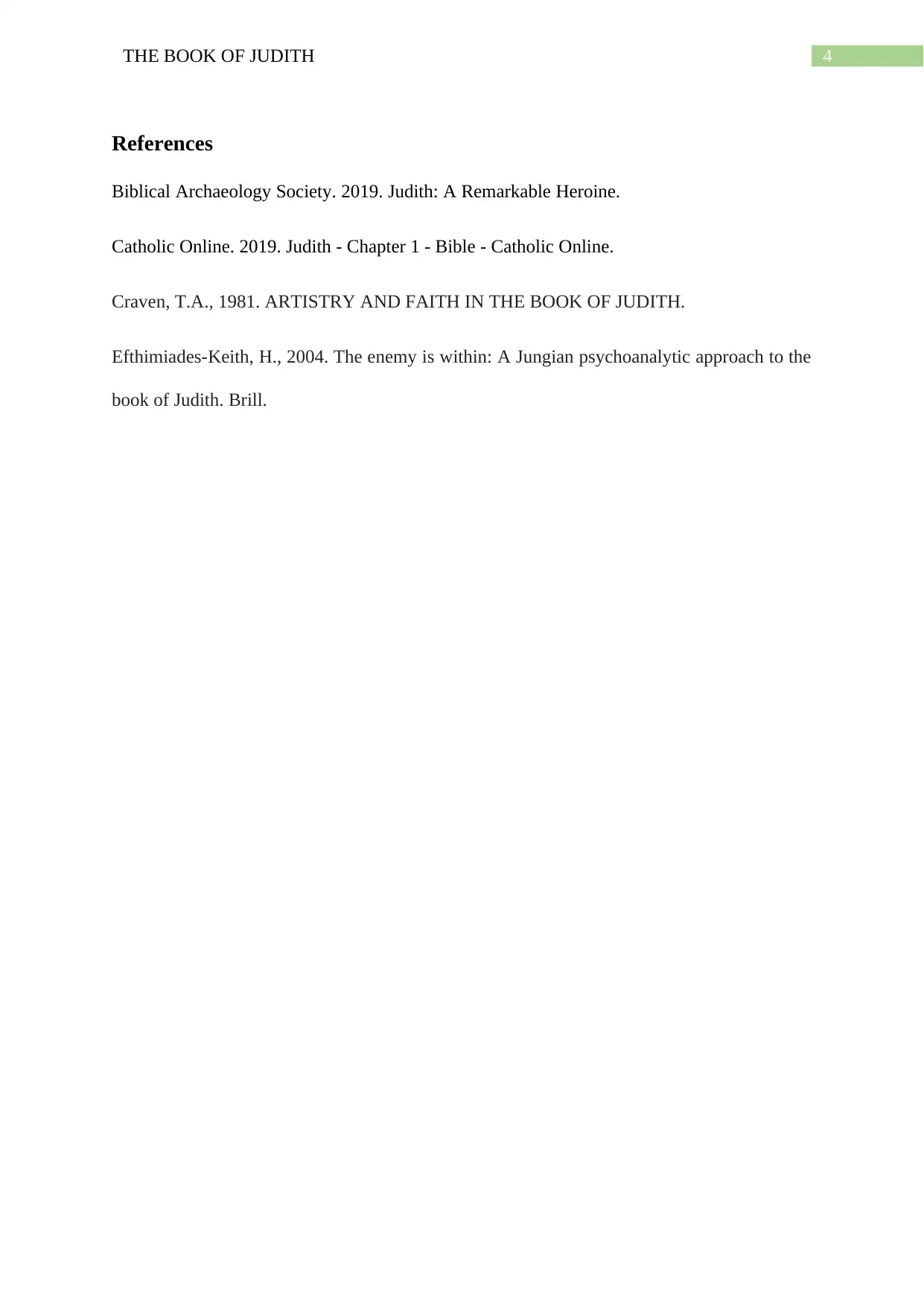
4THE BOOK OF JUDITH
References
Biblical Archaeology Society. 2019. Judith: A Remarkable Heroine.
Catholic Online. 2019. Judith - Chapter 1 - Bible - Catholic Online.
Craven, T.A., 1981. ARTISTRY AND FAITH IN THE BOOK OF JUDITH.
Efthimiades-Keith, H., 2004. The enemy is within: A Jungian psychoanalytic approach to the
book of Judith. Brill.
References
Biblical Archaeology Society. 2019. Judith: A Remarkable Heroine.
Catholic Online. 2019. Judith - Chapter 1 - Bible - Catholic Online.
Craven, T.A., 1981. ARTISTRY AND FAITH IN THE BOOK OF JUDITH.
Efthimiades-Keith, H., 2004. The enemy is within: A Jungian psychoanalytic approach to the
book of Judith. Brill.
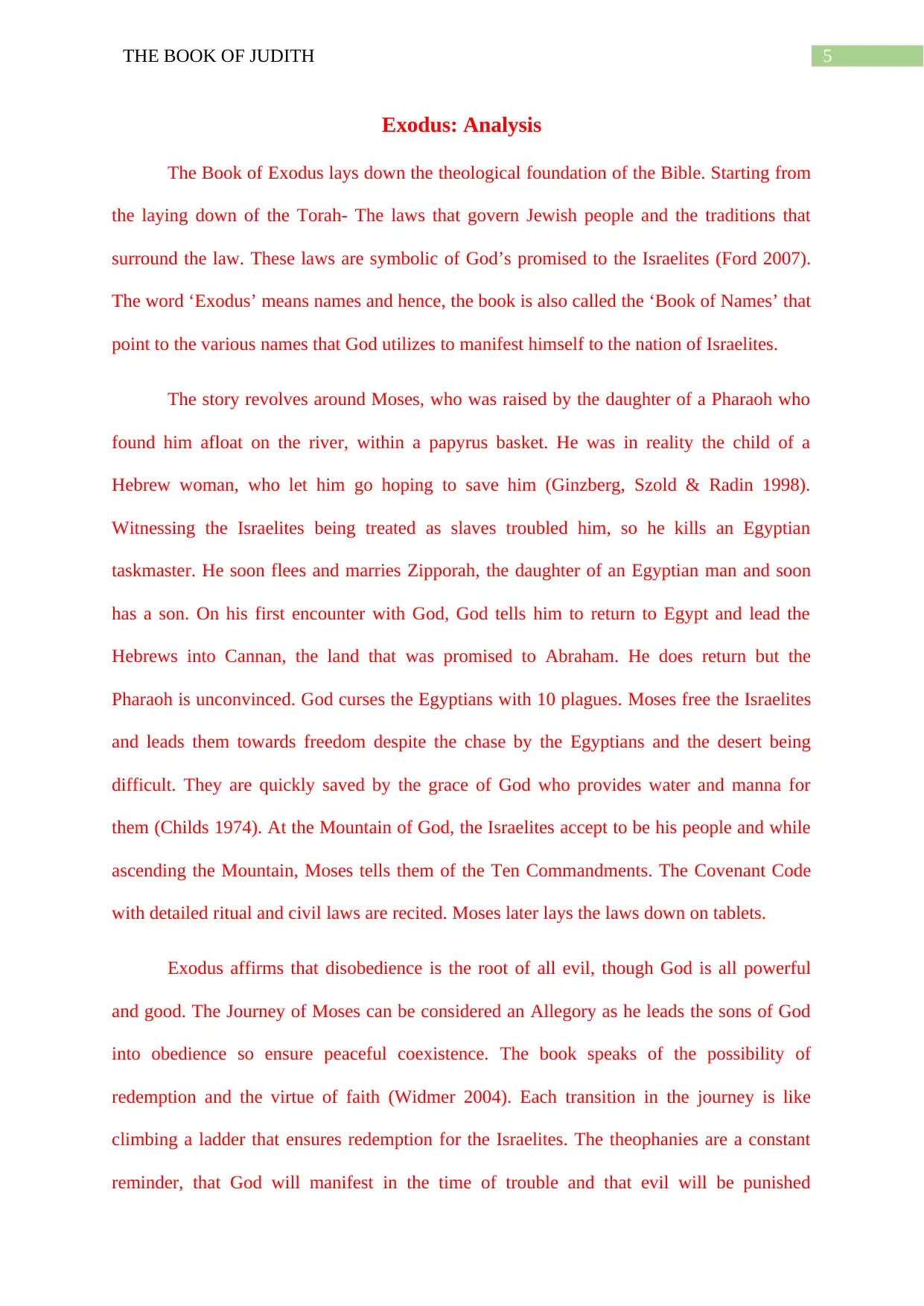
5THE BOOK OF JUDITH
Exodus: Analysis
The Book of Exodus lays down the theological foundation of the Bible. Starting from
the laying down of the Torah- The laws that govern Jewish people and the traditions that
surround the law. These laws are symbolic of God’s promised to the Israelites (Ford 2007).
The word ‘Exodus’ means names and hence, the book is also called the ‘Book of Names’ that
point to the various names that God utilizes to manifest himself to the nation of Israelites.
The story revolves around Moses, who was raised by the daughter of a Pharaoh who
found him afloat on the river, within a papyrus basket. He was in reality the child of a
Hebrew woman, who let him go hoping to save him (Ginzberg, Szold & Radin 1998).
Witnessing the Israelites being treated as slaves troubled him, so he kills an Egyptian
taskmaster. He soon flees and marries Zipporah, the daughter of an Egyptian man and soon
has a son. On his first encounter with God, God tells him to return to Egypt and lead the
Hebrews into Cannan, the land that was promised to Abraham. He does return but the
Pharaoh is unconvinced. God curses the Egyptians with 10 plagues. Moses free the Israelites
and leads them towards freedom despite the chase by the Egyptians and the desert being
difficult. They are quickly saved by the grace of God who provides water and manna for
them (Childs 1974). At the Mountain of God, the Israelites accept to be his people and while
ascending the Mountain, Moses tells them of the Ten Commandments. The Covenant Code
with detailed ritual and civil laws are recited. Moses later lays the laws down on tablets.
Exodus affirms that disobedience is the root of all evil, though God is all powerful
and good. The Journey of Moses can be considered an Allegory as he leads the sons of God
into obedience so ensure peaceful coexistence. The book speaks of the possibility of
redemption and the virtue of faith (Widmer 2004). Each transition in the journey is like
climbing a ladder that ensures redemption for the Israelites. The theophanies are a constant
reminder, that God will manifest in the time of trouble and that evil will be punished
Exodus: Analysis
The Book of Exodus lays down the theological foundation of the Bible. Starting from
the laying down of the Torah- The laws that govern Jewish people and the traditions that
surround the law. These laws are symbolic of God’s promised to the Israelites (Ford 2007).
The word ‘Exodus’ means names and hence, the book is also called the ‘Book of Names’ that
point to the various names that God utilizes to manifest himself to the nation of Israelites.
The story revolves around Moses, who was raised by the daughter of a Pharaoh who
found him afloat on the river, within a papyrus basket. He was in reality the child of a
Hebrew woman, who let him go hoping to save him (Ginzberg, Szold & Radin 1998).
Witnessing the Israelites being treated as slaves troubled him, so he kills an Egyptian
taskmaster. He soon flees and marries Zipporah, the daughter of an Egyptian man and soon
has a son. On his first encounter with God, God tells him to return to Egypt and lead the
Hebrews into Cannan, the land that was promised to Abraham. He does return but the
Pharaoh is unconvinced. God curses the Egyptians with 10 plagues. Moses free the Israelites
and leads them towards freedom despite the chase by the Egyptians and the desert being
difficult. They are quickly saved by the grace of God who provides water and manna for
them (Childs 1974). At the Mountain of God, the Israelites accept to be his people and while
ascending the Mountain, Moses tells them of the Ten Commandments. The Covenant Code
with detailed ritual and civil laws are recited. Moses later lays the laws down on tablets.
Exodus affirms that disobedience is the root of all evil, though God is all powerful
and good. The Journey of Moses can be considered an Allegory as he leads the sons of God
into obedience so ensure peaceful coexistence. The book speaks of the possibility of
redemption and the virtue of faith (Widmer 2004). Each transition in the journey is like
climbing a ladder that ensures redemption for the Israelites. The theophanies are a constant
reminder, that God will manifest in the time of trouble and that evil will be punished
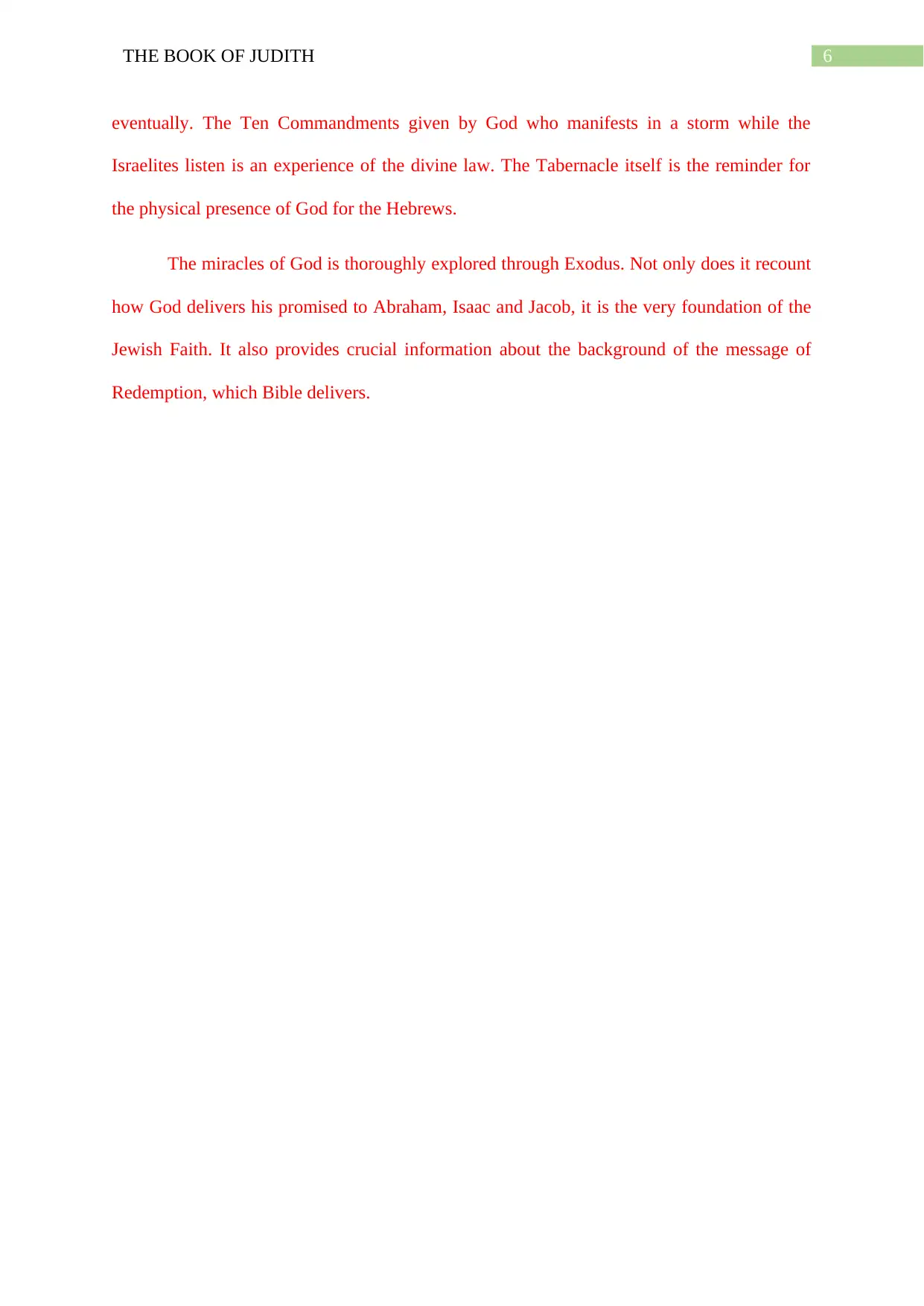
6THE BOOK OF JUDITH
eventually. The Ten Commandments given by God who manifests in a storm while the
Israelites listen is an experience of the divine law. The Tabernacle itself is the reminder for
the physical presence of God for the Hebrews.
The miracles of God is thoroughly explored through Exodus. Not only does it recount
how God delivers his promised to Abraham, Isaac and Jacob, it is the very foundation of the
Jewish Faith. It also provides crucial information about the background of the message of
Redemption, which Bible delivers.
eventually. The Ten Commandments given by God who manifests in a storm while the
Israelites listen is an experience of the divine law. The Tabernacle itself is the reminder for
the physical presence of God for the Hebrews.
The miracles of God is thoroughly explored through Exodus. Not only does it recount
how God delivers his promised to Abraham, Isaac and Jacob, it is the very foundation of the
Jewish Faith. It also provides crucial information about the background of the message of
Redemption, which Bible delivers.
Paraphrase This Document
Need a fresh take? Get an instant paraphrase of this document with our AI Paraphraser
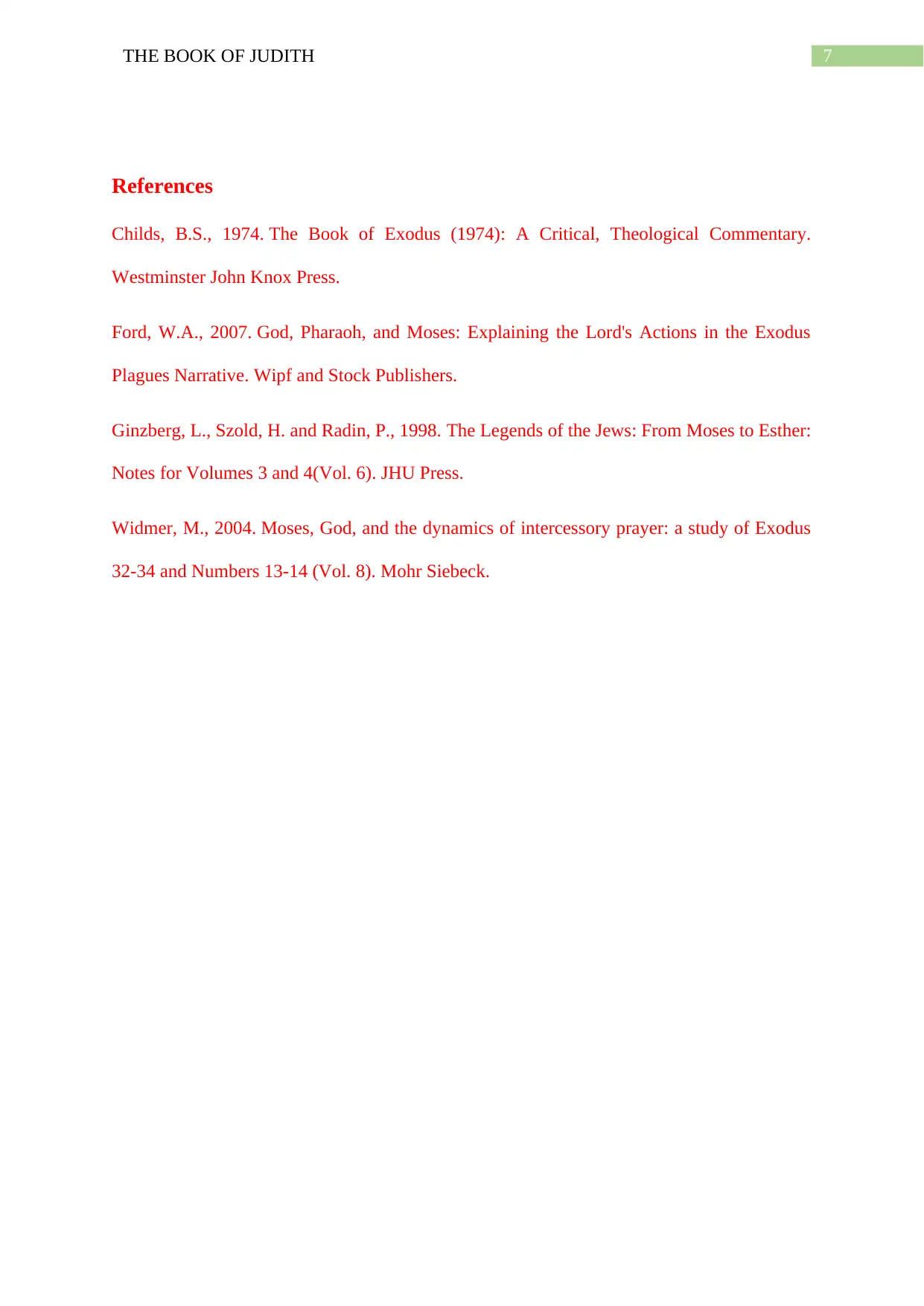
7THE BOOK OF JUDITH
References
Childs, B.S., 1974. The Book of Exodus (1974): A Critical, Theological Commentary.
Westminster John Knox Press.
Ford, W.A., 2007. God, Pharaoh, and Moses: Explaining the Lord's Actions in the Exodus
Plagues Narrative. Wipf and Stock Publishers.
Ginzberg, L., Szold, H. and Radin, P., 1998. The Legends of the Jews: From Moses to Esther:
Notes for Volumes 3 and 4(Vol. 6). JHU Press.
Widmer, M., 2004. Moses, God, and the dynamics of intercessory prayer: a study of Exodus
32-34 and Numbers 13-14 (Vol. 8). Mohr Siebeck.
References
Childs, B.S., 1974. The Book of Exodus (1974): A Critical, Theological Commentary.
Westminster John Knox Press.
Ford, W.A., 2007. God, Pharaoh, and Moses: Explaining the Lord's Actions in the Exodus
Plagues Narrative. Wipf and Stock Publishers.
Ginzberg, L., Szold, H. and Radin, P., 1998. The Legends of the Jews: From Moses to Esther:
Notes for Volumes 3 and 4(Vol. 6). JHU Press.
Widmer, M., 2004. Moses, God, and the dynamics of intercessory prayer: a study of Exodus
32-34 and Numbers 13-14 (Vol. 8). Mohr Siebeck.
1 out of 8
Your All-in-One AI-Powered Toolkit for Academic Success.
+13062052269
info@desklib.com
Available 24*7 on WhatsApp / Email
![[object Object]](/_next/static/media/star-bottom.7253800d.svg)
Unlock your academic potential
© 2024 | Zucol Services PVT LTD | All rights reserved.